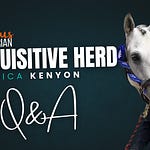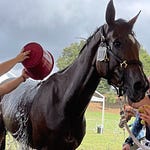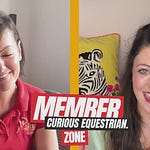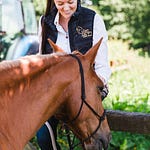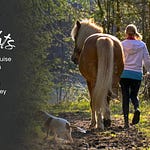"Modern dressage is a bit of a cookie cutter type thing," says Jessica Kenyon, a classical dressage trainer who's spent years watching the sport drift away from its roots. "You have to fit the mold and do the movements exactly how the judges want you to do them."
It's a blunt assessment, but one that reflects what many riders are feeling. Somewhere along the way, dressage stopped being about bringing out the best in each individual horse and became about fitting horses into predetermined boxes.
The Question That Started It All
"What's the difference between classical and modern dressage?" seems simple enough. But Jessica Kenyon's answer revealed something most riders never consider: we might be training our horses to perform rather than communicate.
This episode covers:
Why modern dressage became "cookie cutter" training
What happens when connection isn't part of the scoring system
How cavalry training principles still matter for weekend riders
The real story behind those viral training videos
Our Expert Guest:
Jessica Kenyon is a classical dressage trainer based Bury (England), dedicated to ethical, connection-based training that puts harmony between horse and rider at the centre. She helps riders of all levels rediscover the practical, natural roots of dressage while building genuine partnerships with their horses.
Instagram: @jessicakennykenyon Facebook: “Jessica Kenyon Classical Dressage”
The Bottom Line
Your horse's willingness to work with you matters more than perfect execution of movements. Jessica's classical approach puts this partnership first—everything else follows from that foundation.
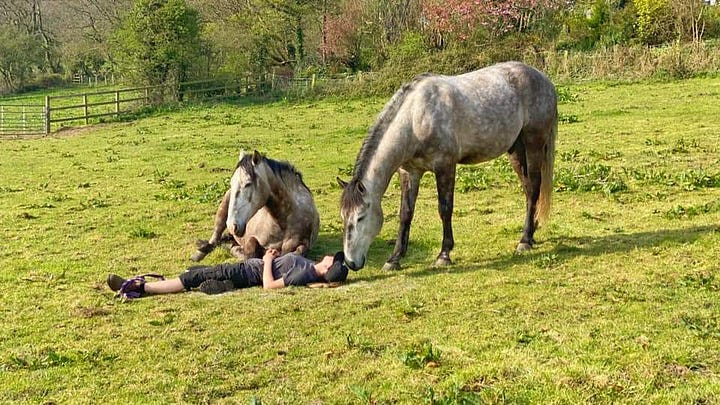
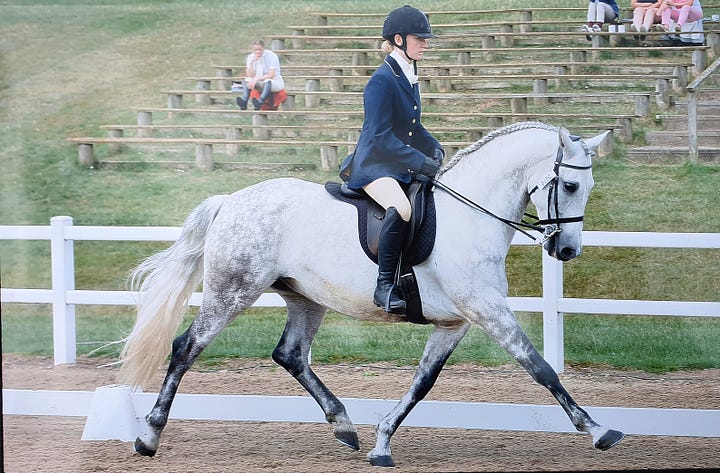
Three Things That Stood Out
1. "Horses weren't meant to be piaffing in the field"
Jessica's observation cuts to the heart of modern dressage's identity crisis. While movements like piaffe and passage look spectacular, classical dressage asks whether the horse is performing them naturally and willingly, or being forced into an unnatural frame for visual impact.
It matters because it affects everything from the horse's physical wellbeing to the sustainability of the training, when movements are developed naturally, they enhance the horse's strength and balance. When forced, they create stress patterns that often lead to injury and resistance.
2. The practical origins of dressage movements
Every classical dressage movement had a purpose—cavalry horses needed lateral work to avoid enemy attacks, Spanish horses in bullfighting had to execute pirouettes when a bull changed direction. These weren't choreographed performances but survival skills.
Jessica explains how these training methods evolved: "They were movements made to farm. They've gotta be nimble, move sideways and the pirouettes, they've gotta spin round if the bull decides to go the other way." Modern dressage has turned these practical skills into a timed test judged on precision rather than functionality.
This disconnect explains why classical training emphasises movements you actually need when riding outside the arena. The same leg aids that create shoulder-in can position your horse safely when passing cars. The halt that develops from proper engagement means your horse can stop when needed, not just when judges are watching.
3. "You should be able to lead that horse with no head collar on"
This simple statement reveals how far many riders have drifted from basic horsemanship. Before thinking about advanced movements, Jessica starts with fundamental connection—can the horse trust you enough to follow your lead without force?
This approach challenges the modern tendency to jump straight to riding without establishing genuine communication on the ground. It's a return to viewing horses as partners rather than vehicles for our ambitions.
Deep Dive
Training Methods: Starting with Connection
Jessica's approach challenges the conventional progression most riders learn. Instead of moving quickly from basic control to advanced movements, she starts with something most riders can't do: "You should be able to lead that horse with no head collar on."
This isn't just a party trick. Leading without equipment requires genuine communication—the horse following your energy and intention rather than physical restraint. Jessica often spends initial sessions just establishing this connection: "A lot of it is getting over people's mental blocks, and they think that they don't have a connection with the horses."
The classical training methods she uses build from this foundation. Before asking for lateral work under saddle, she'll teach the same responses from the ground using a long dressage whip as an extension of the rider's leg aid. The horse learns the movement without the complication of carrying a rider's weight or dealing with conflicting aids.
The Connection Crisis in Modern Competition
Watch any dressage competition and you'll see horses performing movements with mechanical precision. But look closer—how many appear genuinely willing? How many seem to enjoy their work?
The problem isn't evil trainers or corrupt judges. It's a system that rewards what's easiest to score. A perfectly timed flying change gets marks. The horse's emotional state during that change doesn't.
Classical dressage trainers like Jessica work differently. They might spend months just establishing trust and communication before asking for any advanced movements. In competition terms, this seems inefficient. In horse welfare terms, it makes perfect sense.
The Ethics of Modern Training Methods
The Charlotte Dujardin video that led to her ban brought training methods into sharp focus, but Jessica's perspective offers nuanced insight. Rather than condemning individuals, she sees these incidents as symptoms of a system that prioritises results over process.
When success is measured by performance in the ring rather than the quality of the training relationship, pressure builds to achieve movements through any means necessary. This creates an environment where harsh methods can seem justified by competitive success.
Classical training offers an alternative framework where the means matter as much as the ends. If a horse performs a movement through fear or force, it's not considered successful regardless of how it looks to judges or spectators.
Practical Applications Beyond the Arena
Here's what classical dressage principles actually look like in real life: your horse willingly moves away from your leg when a car approaches on a hack. It backs up when you shift your weight slightly. It turns through a narrow gateway without you having to haul on the reins.
Jessica trains these responses not through repetition drills but by helping horses understand what's being asked. Working equitation, the Portuguese discipline she mentions, tests exactly these practical skills—bridges, gates, tight turns around obstacles that mirror real riding situations.
The same leg aid that creates shoulder-in in the arena helps position your horse safely on a narrow bridle path. The halt that develops from proper engagement means your horse can stop when a dog runs out unexpectedly, not just when judges are watching.
The Breed Factor: Why Spanish and Portuguese Horses Excel
Jessica's preference for Spanish and Portuguese horses reveals something important about classical horsemanship. These breeds were developed for the original purposes dressage movements served—bullfighting, cavalry work, practical farm tasks requiring agility and quick responses.
"They're just so athletic and brave," Jessica explains. "You'll see so many demos of horses that have been trick trained with classical dressage backgrounds. And they're waiting and their ears are on them. And they'll even do things on their own accord just to go, is this what you want?"
This willingness comes from breeding, but also from training methods that make work feel like play rather than obligation. These horses demonstrate what happens when classical training methods align with natural temperament—eager partners rather than reluctant performers.
Questions for Reflection
How well do you know your horse's individual personality and preferences? Jessica emphasises that connection requires understanding each horse as an individual. Many riders focus on getting their horse to respond correctly without considering what the horse is trying to communicate back.
When you encounter resistance from your horse, do you first look for understanding or compliance? Classical training views resistance as communication—the horse saying something isn't working. Modern training often treats it as disobedience to overcome.
Could you achieve your riding goals without any artificial aids? This question challenges riders to consider whether their partnership is based on communication or control. While equipment has its place, classical principles suggest the relationship should work first without artificial support.
Frequently Asked Questions
Can any horse learn classical dressage movements? Based on Jessica's experience, yes. She emphasizes that all horses are naturally capable of the movements we see in dressage—watch any horse playing in a field and you'll see passage, piaffe, and lateral movement. The challenge isn't the horse's ability but how we ask for these movements and whether we maintain their natural willingness.
How long does it take to establish the connection Jessica talks about? This varies dramatically between partnerships. Jessica mentions spending months just on groundwork and connection before moving to advanced movements. The key is not rushing the timeline but ensuring each stage is solid before progressing.
What if my horse was trained using modern methods—can we switch to classical principles? Jessica works with many horses who've been conventionally trained. The approach involves going back to basics, often starting with simple leading exercises to rebuild communication. Horses typically respond well to training that asks for their cooperation rather than compliance.
Do I need special equipment for classical dressage training? Jessica's approach actually uses minimal equipment. She often works horses without head collars and emphasizes that if you need lots of gear to get a response, you might be missing the communication piece. A long dressage whip for groundwork and basic tack is usually sufficient.
Is classical dressage only for certain breeds? While Jessica admires Spanish and Portuguese horses because of their bred-in work ethic, she believes any horse can benefit from classical principles. The approach adapts to each horse's individual temperament and physical capabilities.
How do classical principles apply if I don't want to compete? This might actually be where classical dressage shines most. The emphasis on practical movement, willing partnership, and real-world application makes it ideal for riders who want better communication and safer, more enjoyable rides rather than competition success.
What Classical Dressage Can Teach Any Horse (and Rider)
So many riders wonder if their horse has the right temperament, the right breed, or even the right attention span for dressage. Add to that the judgmental glances at the yard, and it can feel like an exclusive club. In this episode, trainer Jessica Kenyon makes the case that classical dressage is for every horse—cobs, donkeys, sharp personalities, and even the so-called “lazy” ones.
You might also enjoy this interview where we discussed Dressage In Hand:
Josefa Guillaume, International Horse Trainer and Author of Dressage In Hand
In this conversation, we explore the insights of Josefa Guillaume, an international horse trainer, instructor, and author of Dressage in Hand: What Horses Want You to Know. Josefa has dedicated over twenty years to working with horses, including injured and traumatized animals, focusing on teaching dressage movements from the ground rather than the saddle. Anna Louise and Josefa dive into the evolving perception of horses within the equestrian community, the ethical challenges facing dressage competition today, and the potential transformation that could come from viewing horses as pets rather than mere sporting animals.






